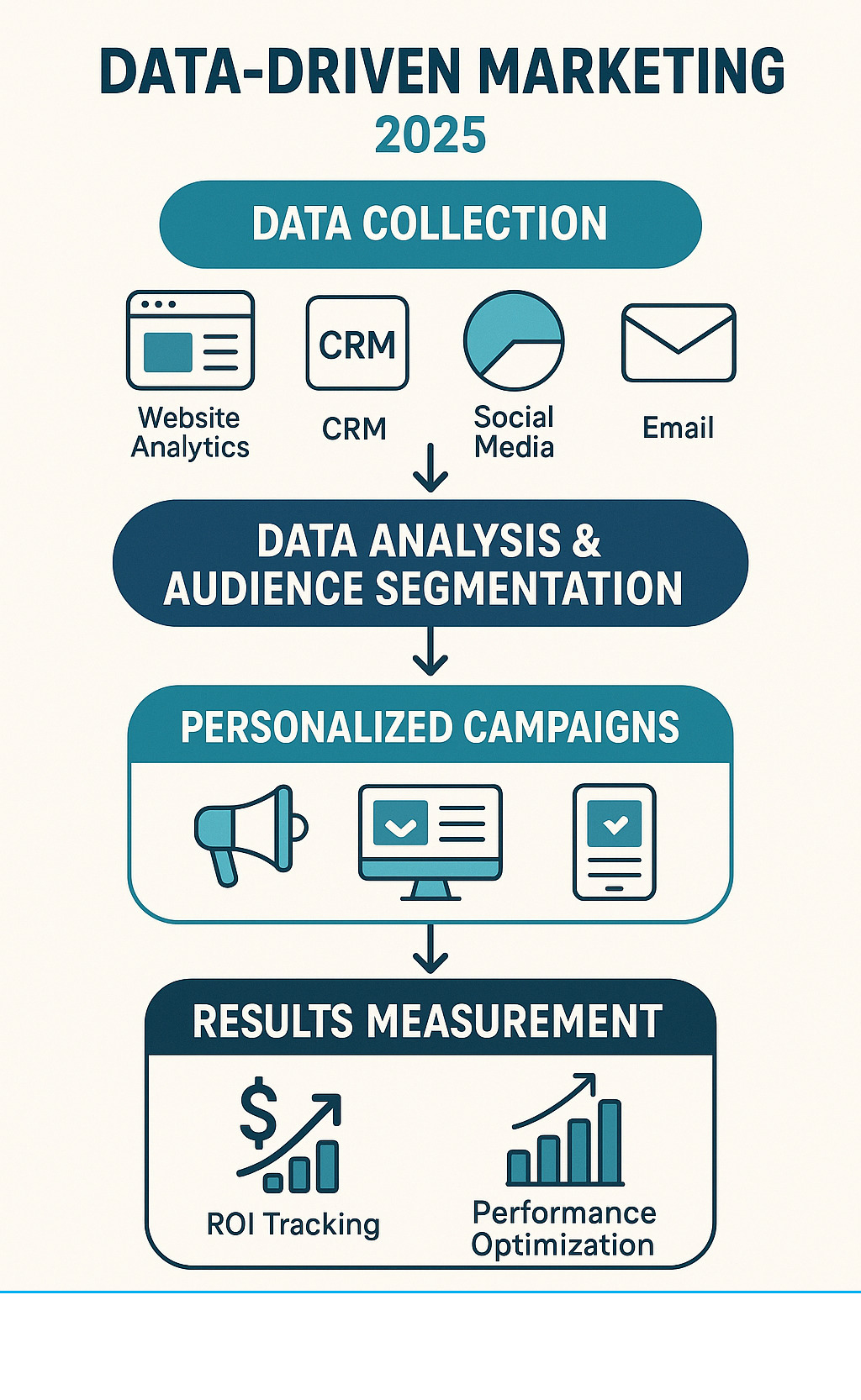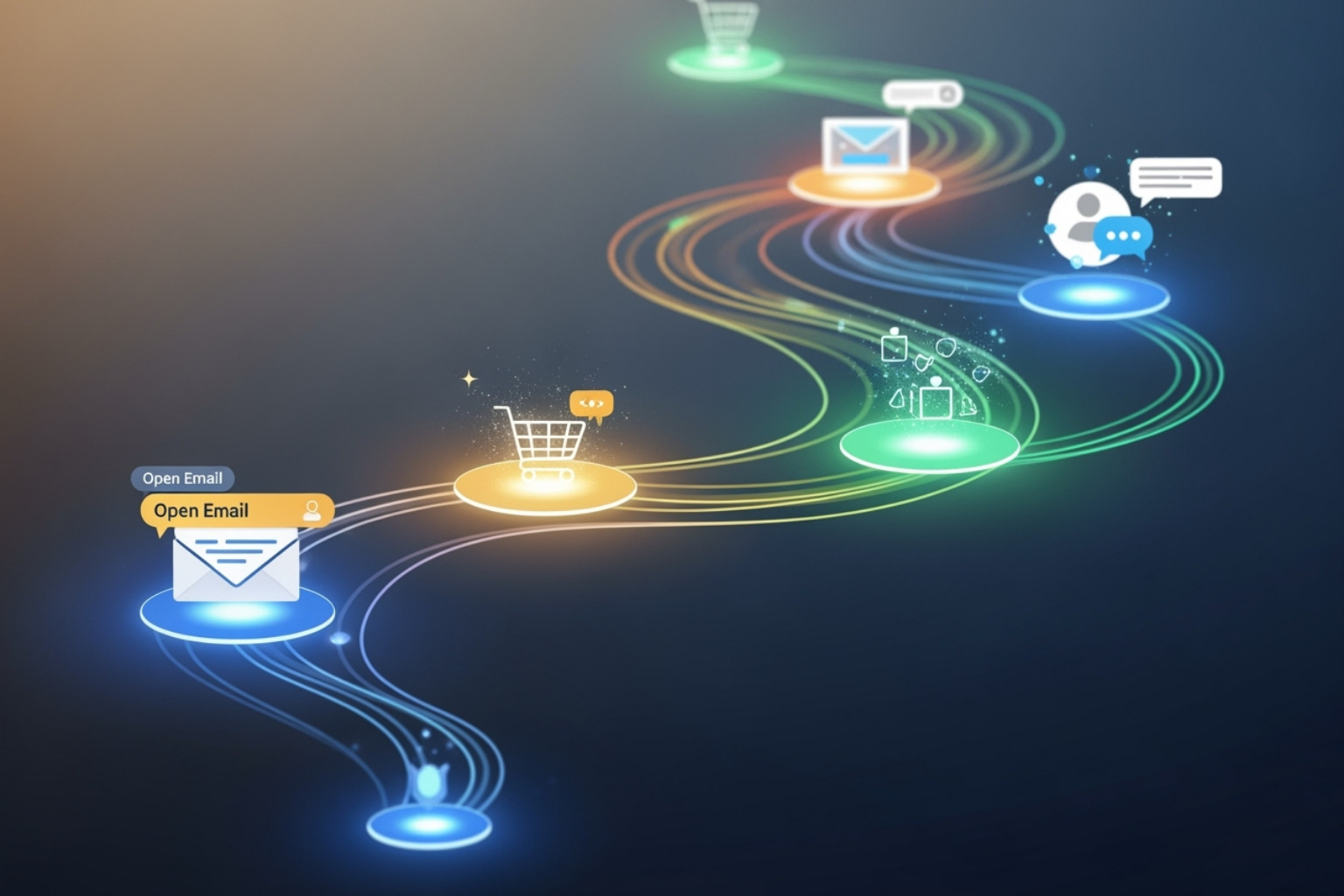From Data to Dollars: Mastering Marketing with Smart Strategies
Master data-driven marketing strategies to boost ROI, personalize campaigns, and leverage AI for unparalleled business growth.
Master data-driven marketing strategies to boost ROI, personalize campaigns, and leverage AI for unparalleled business growth.

Data-driven marketing strategies are changing how businesses connect with customers and drive growth. Instead of relying on gut feelings, these strategies use concrete data to make smarter decisions about who to target, what to say, and when to engage.
The shift from traditional marketing isn't just a trend—it's essential for survival. While 87% of marketers say data is their company's most under-used asset, businesses using data-driven strategies drive five to eight times more ROI than those who don't.
For tech startups launching new products, this approach is particularly powerful. Data helps you understand your market before investing heavily in campaigns, identify messaging that resonates with early adopters, and optimize your marketing spend for maximum impact. Unlike traditional mass campaigns, data-driven marketing lets you target the right people with the right message at the right time.
I'm Tony Crisp, and I help tech companies use data-driven marketing strategies to turn customer insights into measurable growth, guiding everything from brand positioning to AI-powered personalization.

Data-driven marketing strategies terms simplified:
Think of data-driven marketing strategies as building your brand on solid ground instead of shifting sand. When launching a tech product, you can't afford to guess what your audience wants—you need to know.

At CRISPx, we see companies collecting tons of customer information that sits trapped in different systems. Your CRM knows purchase history, your website analytics track browsing behavior, and your social media shows engagement—but they're all telling separate stories.
This is where first-party data becomes your secret weapon. It's the information customers give you directly through your website, apps, and purchases. Unlike third-party data, it's accurate, relevant, and belongs to you.
The magic happens when you connect these data sources into a unified customer view. Suddenly, you know a visitor to your pricing page is also a returning customer who follows you on LinkedIn. That's the foundation for building real brand value and laser-focused brand positioning. Our Data Analysis for Marketing approach helps break down these data silos.
Building effective data-driven marketing strategies starts with understanding your data's value.
First-party data is your goldmine. This includes your CRM data (customer interactions, purchase history), web analytics from tools like Google Analytics 4, mobile app data showing user engagement, and transaction data revealing buying patterns. An often-overlooked source is conversation analytics from calls or chats, which contain insights into customer motivations and pain points.
Second-party data comes from partnerships, where another company shares its first-party data with you, providing a warm introduction to potential customers.
Third-party data is the broadest but least precise option. It's useful for finding new audiences, but privacy regulations are making it less reliable. Smart brands focus on building their first-party data collection instead.
The key is to integrate these sources. When your web analytics, CRM, and conversation data work together, you get a complete picture that drives better decisions.
Knowing your audience means going deeper than basic demographics. Behavioral data tells you what people do, not just who they are.
Combining these three data types makes audience segmentation powerful. You can group customers based on shared characteristics, leading to detailed buyer personas that feel like real people. Data-driven competitive analysis also helps you find market trends and gaps your competitors are missing.
As we show in our guide on How Data Helped Sharpen Product-Market Fit: Guiding Your Brand's Position, the goal isn't just to collect more data—it's to turn the right data into insights that guide your brand strategy.
Once your data foundation is solid, it's time to put it to work. This is where OrbitX—our framework for executing growth marketing with psychology—transforms insights into action, creating experiences that make customers feel truly understood.

The numbers tell a compelling story: 80% of customers are more likely to purchase from brands that provide personalized experiences, and 71% of consumers now expect it. When companies miss the mark, 76% of consumers get frustrated. For growing businesses, this is about revenue: companies that excel at personalization generate 40% more revenue and see 5x to 8x higher ROI on marketing.
However, the modern customer journey is complex, involving anywhere from 20 to 500 touchpoints. That's a lot of opportunities to either delight or disappoint, and 32% of customers will leave a brand after just one bad experience.
This is where data-driven marketing strategies become your secret weapon. By mapping customer journeys and using data to identify pain points, you can optimize every interaction. We use continuous A/B testing to refine messaging and user experiences, ensuring every change is backed by data, not gut feelings. For more on this, see our guide on Data-Driven Customer Insights.
The magic happens when you combine personalization with automation. Dynamic content creates experiences in real-time based on user behavior. An auto dealer might show a homepage image of the exact car a visitor inquired about; a lawn care provider could email neighborhood-specific offers based on past conversations.
Other key tactics include:
Meeting the expectation for personalization—which 71% of consumers expect—is essential for success.
Data-driven strategies deliver tangible results. Netflix uses viewer history to power its content recommendations, increasing watch time and satisfaction. Spotify's annual "Wrapped" campaign turns individual listening data into viral social content, boosting engagement and retention. Lego's "Adults Welcome" campaign used market research on adult hobbies to successfully expand into a new demographic, driving significant revenue growth.
One powerful example is DirecTV, which used USPS change-of-address data to create personalized homepage experiences for new movers. This targeted approach outperformed generic offers, proving that the right data can be more valuable than a bigger discount. These examples show that data isn't just about numbers—it's about understanding human behavior and crafting experiences that resonate.
Artificial intelligence is revolutionizing data-driven marketing strategies. Think of AI not as a replacement for human creativity, but as a powerful amplifier that takes your marketing efforts from good to extraordinary.

93% of marketers believe AI will have a positive impact, and 86% are boosting their AI spending to prove it. Why? Because AI transforms basic automation into intelligent systems that learn, adapt, and improve. While traditional automation follows simple rules, AI analyzes massive datasets to predict what customers will do next.
At CRISPx, we see AI as a survival tactic. It processes data from website visits, purchase history, and even conversation analytics to spot patterns humans might miss. Our guide on AI in Digital Marketing explores how this technology is reshaping the marketing landscape.
The real power emerges when AI and marketing automation work together.
This intelligent automation frees your team for strategic thinking, which we explore in The AI Effect: How Machine Intelligence Is Redefining Consumer Engagement.
The future of data-driven marketing strategies is taking shape now. Key trends include:
Staying ahead of these trends is crucial. Learn more in our guide, Preparing for the Future of Human-Computer Interaction: Voice, Vision, and AI.
Implementing data-driven marketing strategies can be challenging. Many teams struggle with similar problems, from poor data quality to organizational problems. In fact, 81% of marketers find implementing a data-driven strategy complicated.
Overcoming these challenges is about making steady progress. Here are the most common issues and how to tackle them:
Challenge: Data Silos and Poor Quality. Customer data is often scattered across platforms and inaccurate. Only 8% of companies store all their data in one place. Solution: Unify your data. Implement a customer data platform (CDP) or data warehouse to create a single source of truth that everyone can trust.
Challenge: Skills Gap and Complex Tools. Marketing teams are often asked to become data scientists overnight. Solution: Invest in practical training and user-friendly tools. The goal is to empower your team to understand and act on insights, not to bury them in complexity.
Challenge: Shifting Company Culture. Moving from "gut feelings" to data-backed decisions requires a fundamental change. Solution: Foster a data-first culture starting from the top. When leadership asks, "What does the data say?" it signals that evidence-based decisions are valued.
Our team explores these solutions in more detail in Data Analysis in Marketing.
Data privacy is about building trust, a cornerstone of any successful strategy. Regulations like Europe's General Data Protection Regulation (GDPR) and the California Consumer Privacy Act (CCPA) set the standard. The key principles are straightforward:
Respecting privacy isn't just about compliance; it's a competitive advantage.
You must prove that your efforts are driving business results. Focus on metrics that connect marketing to revenue:
We use marketing dashboards to visualize these KPIs in real-time, turning data into action. Our expertise in Data Visualisation Design ensures these dashboards are clear and effective. For example, a healthcare client used this approach to achieve a 74% decrease in patient acquisition cost.
Here are answers to common questions from tech founders and marketing teams starting their journey with data-driven marketing strategies.
Start by defining clear business goals. Are you trying to increase leads, improve customer retention, or boost conversion rates? Your goals determine which data and metrics matter most, preventing you from getting lost in irrelevant information. This focus guides your entire strategy from the beginning.
You likely have more valuable data than you realize. Start with what's already available: your CRM, website analytics like Google Analytics, and social media insights. Focus on a few key performance indicators tied to your goals. Even simple actions, like segmenting your email list based on purchase history or analyzing customer feedback, can yield significant results. Start small, prove the value, and scale from there.
Data transforms generic marketing into meaningful, relevant interactions that customers appreciate. It enables personalization at scale, which 80% of customers are more likely to purchase from. By analyzing behavior, you can anticipate customer needs, identify and fix pain points in their journey, and deliver messages at the perfect time. This makes customers feel understood, which builds the trust and loyalty that drive long-term growth.
The journey through data-driven marketing strategies reveals a fundamental truth: modern marketing success isn't about the biggest budget, but the clearest understanding of your customers.
It's about creating genuine connections by delivering personal, valuable experiences. When you can anticipate what your customers need, you're not just marketing—you're building a brand that resonates.
At CRISPx, our DOSE Method™ puts these principles into action. We combine the solid data foundations of LaunchX, the growth-focused execution of OrbitX, and the power of AI to scale your efforts efficiently. The shift to data-driven marketing requires a new mindset—one that values insights over assumptions and testing over guessing.
It's time to build a culture where every decision is backed by evidence and every campaign is an opportunity to learn and improve. The future belongs to brands that can turn data into meaningful human connections.
Ready to join them? Let us help you launch your brand with data-driven creativity and transform your marketing from guesswork into a growth engine.